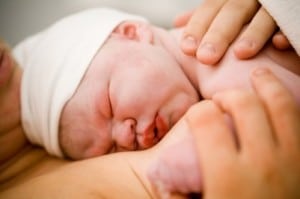
The large Dutch study collected information on nearly 150,000 women who gave birth in the Netherlands between 2004 and 2006, all of which had low-risk pregnancies. Out of those women, 92,333 had a planned home birth and 54,419 had a planned hospital birth.
According to researchers from the Royal College of Midwives, the overall risk of severe complications to be one in 1,000 for home births and 2.3 in 1,000 for hospital births. More specifically, the risks of needing either a blood transfusion or to be admitted to intensive care was lower for women having their first child who had a home birth – 2.3 per 1,000 for home births compared to 3.1 per 1,000 for planned hospital births.
During the birth of a second child, these and other risks were notably lower in home births than they were in hospital births. For example, the risk of severe blood loss after delivery (postpartum hemorrhage) was 19.6 percent per 1,000 of planned home births, but the rate increased dramatically to 37.6 per 1,000 for planned hospital births.
Currently, about 20% of all births in the Netherlands are home births. Ank de Jonge, a practicing midwife and senior researcher on the study from the VU University Medical Center in Amsterdam said the findings show the current system is working well. However, she also emphasized that these are best case scenario pregnancies where the risks to both mom and baby are low. She also stressed that there are some very important aspects to planning a home birth, including having an emergency backup plan.
“This comes from a good risk selection system, good transport in place, and well-trained midwives,” Jonge told BBC News. “Women who give birth at home are less likely to have interventions at home, but if there is a serious problem, there should be a system to deal with them.”
So what is this study really saying about home birth? That you should have one? Not necessarily; a home birth may not be the right fit for every mom or couple. However, this study does highlight the benefits and safety of home births, and it may help a mom worried about such things the confidence to move forward and ask more questions. And, according to some, this knowledge could help cut costs in countries that offer government funded health insurance.
“This research should be encouraging providers and commissioners of maternity services to put more resources into providing women with a real choice of having a home birth, because at present, we know many women who would want one often cannot have one because of a lack of midwives,” Cathy Warwick, chief executive of the Royal College of Midwives, told BBC News. “Providing choice of birth is at the heart of the government’s agenda, so it was disappointing that last year, we saw a drop in home births. We should be aiming to see home births at the levels of the 1960s when a third of women had their babies in their homes.”
Of course, not everyone is going to completely agree, and the subject of home births has been a hot debate topic for quite some time – so much so that there were issues with purchasing birthing pools in the United States back in 2011. And a 2011 BMJ study of 65,000 English births found that, while planned home deliveries were less likely to end in a C-section or forceps birth, the risk of home birth was higher for the babies of first time moms. Why the difference in study information? It may have something to do with differences between areas. Take the UK, for example.
“The rate of home birth in the UK is low in comparison to the Netherlands where the proximity to specialist services with short transfer times is the norm,” said Dr. Tony Falconer, President of the Royal College of Obstetricians and Gynecologists. “The same advantages are not always available across the UK, so the safety of home birth has to be considered in the context of local services.”
It should also be noted, however, that the 2011 study did find that there was no added risk for second time moms who gave birth at home and second time moms who gave birth in a midwife-led unit or doctor-led hospital. And they found that women who planned to have a home birth were less likely to need a C-section of forceps delivery. And it seems that the RCOG agrees with this point since they do support home births for moms having their second or third child.
“Our High Quality Women’s Health Care report emphasized the need for reorganization of women’s health services around clinical networks,” Falconer said. “There is a greater need for services around clinical networks. There is a greater need for more services to be provided in the community for low-risk women. [However], for more complex cases, women need access to units providing 24-hour constant cover.”
Related Articles:
- First Baby Born Using ‘Safer’ IVF Method
- 60-Year-Old Woman with Stomach Ache Unexpectedly Gives Birth to Baby Girl!
- Antihistamines During Pregnancy May Increase Risk of Adverse Outcomes






